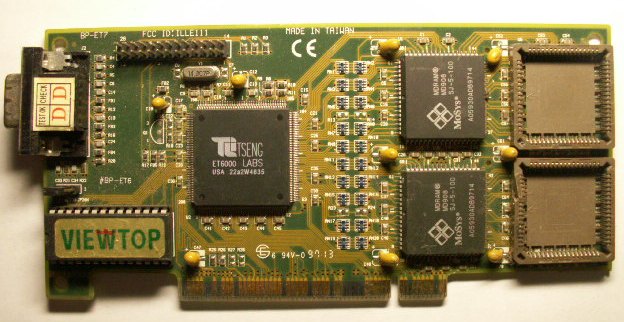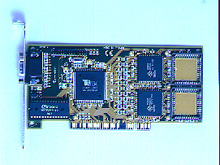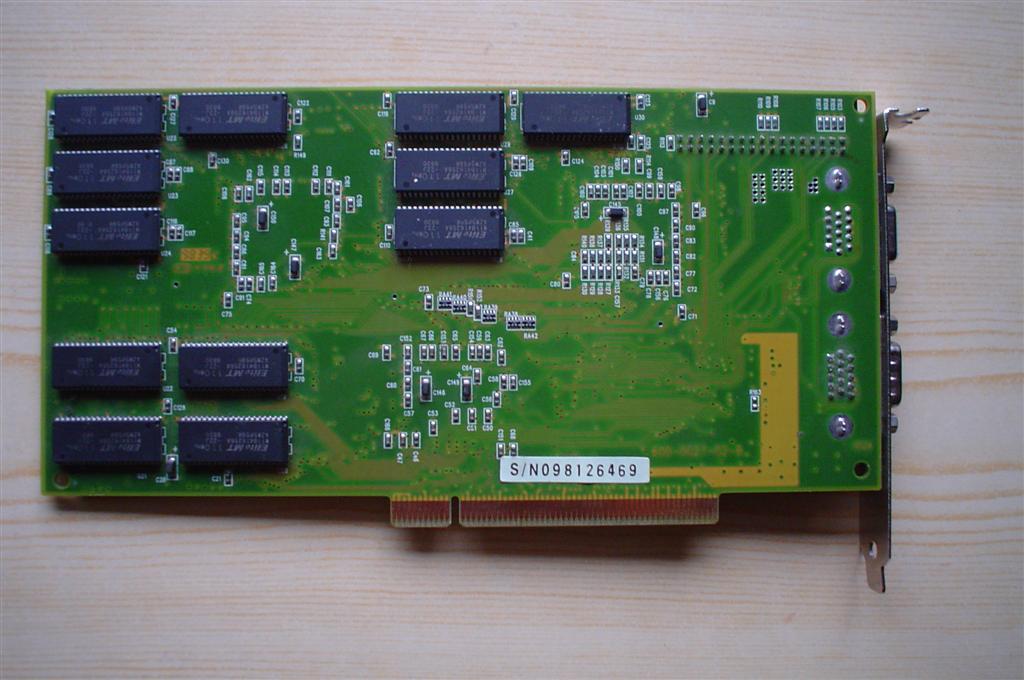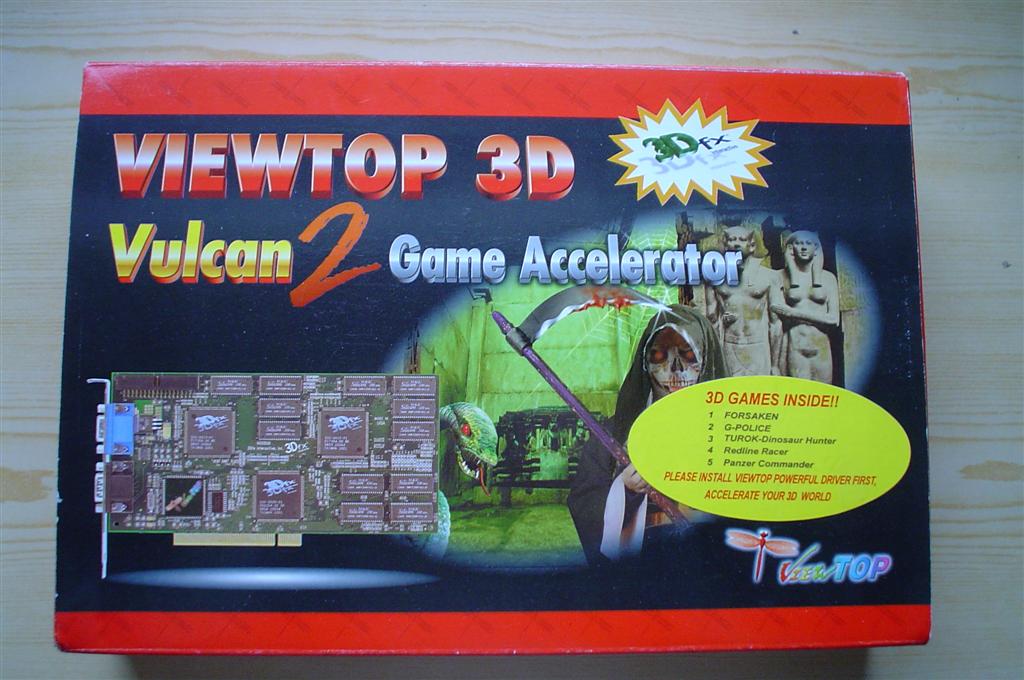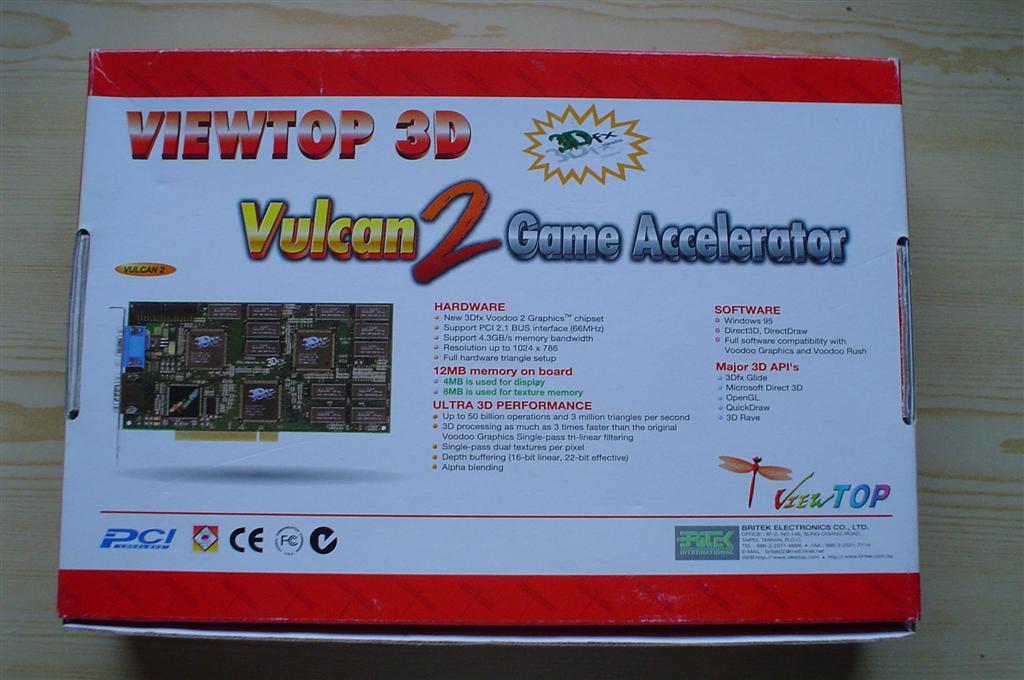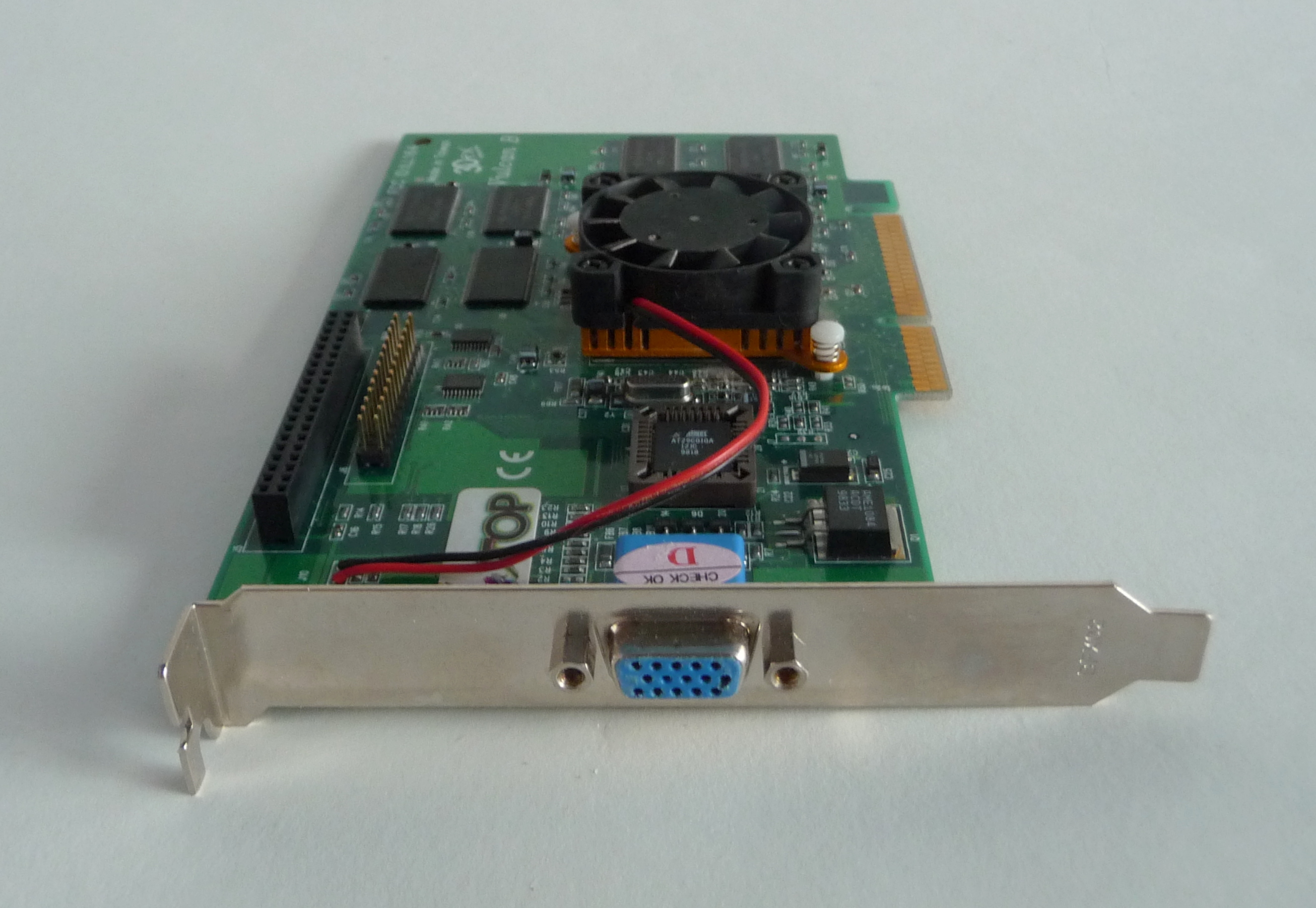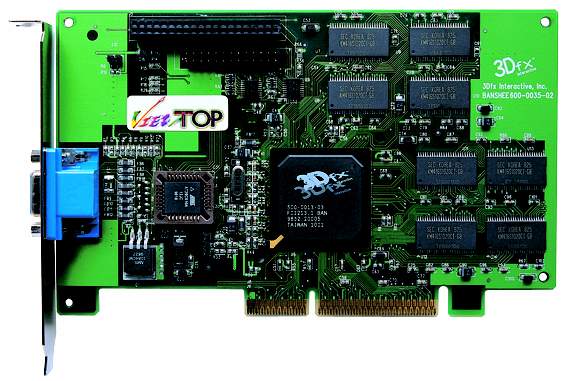 ViewTOP
ViewTOP
ViewTOP was a brand name of Taiwanese manufacturer Britek Electronics Co Ltd. They produced VGA cards from 1990 to early 1999, starting with ISA-based VGA cards before moving to VESA Local Bus and PCI where they jumped on the 3D bandwagon with chipsets from 3dfx, S3 and nVidia.
Graphics Cards
Other Graphics Cards With Little to no Information
|
|||||||||||||||||||||||||||||||||||||||||||||||||
| |||||||||||||||||||||||||||||||||||||||||||||||||
|
|||||||||||||||||||||||||||||||||||||||||||||||||
| - | 256 colors | 32K/64K colors | 16M colors |
| 1MB | 1152x864 | 800x600 | 640x480 |
| 1.5MB | 1152x864 | 800x600 | 800x600 |
| 1.2MB | 1600x1200 | 1152x864 | 800x600 |
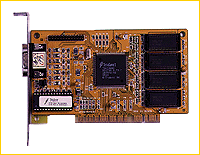 BP-TRX
BP-TRX
Launched: 1995
Bus: PCI or VLB
Chipset: Trident TVGA9680-1XGI
RAMDAC Clock: 135 MHz
Memory Clock: 80 MHz
Memory: 1 MB EDO (expandable to 2 MB)
Specifications:
|
| 1600x1200/16 | I-96Hz |
| 1280x1024/256 | NI-75Hz |
| 1024x768/65K | NI-75Hz |
| 800x600/46.8M | NI-60Hz |
| 640x480/16.8M | NI-75Hz |
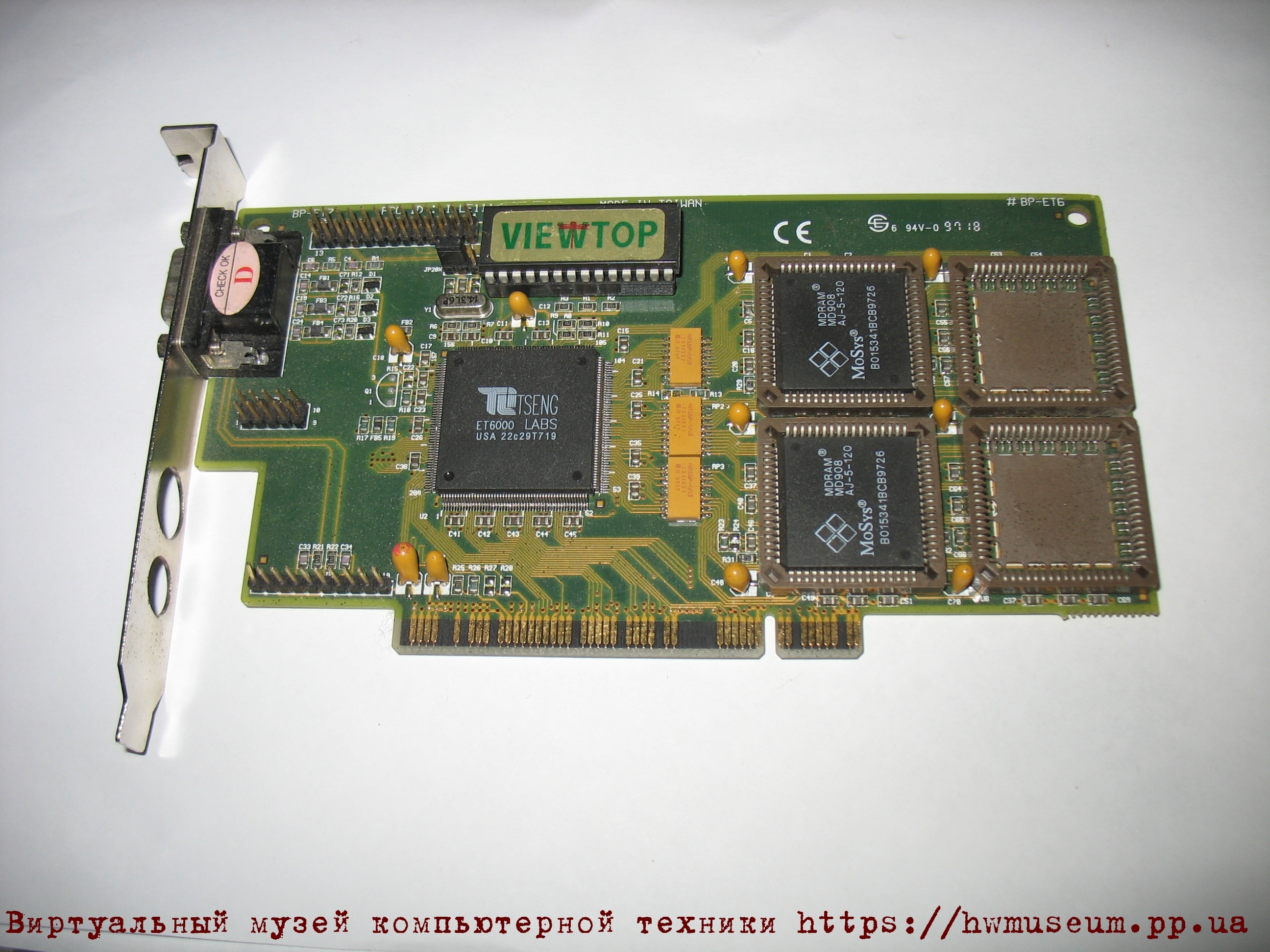 Twister 6100 / BP-ET6 / BP-ET7 / BTV-ET1
Twister 6100 / BP-ET6 / BP-ET7 / BTV-ET1
Launched: 1995
Bus: PCI
Chipset: Tseng Labs ET6100
Memory: 2 MB or 4 MB
Supports: CGA, EGA, VGA, SVGA
FCC ID: ILLE111, ILLE111F
Known Board Revisions: C
The BP-ET6 had a 135 MHz RAMDAC with 92 MHz clock. Memory access was 128-bit width. The card was able to handle MPEG-1 video acceleration in hardware.
The BTV-ET1 model variants came with a TV out port for many regions: BTV-ET1-NM was for the USA and Taiwan market and supported NTSC-M/M. BTV-ET1-NJ was for the Japanese market and supported NTSC-EIA. BTV-ET1-PB was for the Singapore and Holland markets, supporting PAL-B/G. BTV-ET1-PI was for the UK and Hong Kong markets, supported PAL-I. Finally, BTV-ET1-PD was for the Chinese and Polish markets, supporting PAL-D/K.
Specifications:
- Tseng Labs ET6000/ET6100 high performance 128bit Graphics Acceleration.
- Tseng Labs VPR6100 Video Processor - offers 8 or 16-bit live video port using external A/D decoder, horizontal and vertical video interpolation maintains quality of downscaled images.
- Real time Video/TV Capture - Support continuous AVI files capturing with up to 30 fps and single frame snapshot, external input sources include one Composite AV(RCA) and one S-VHS (4 pins mini-din connector).
- Up to 4 Simultaneous scaled video windows.
- Granular MDRAM (Multi-bank DRAM) from 2MB to 4.5MB.
- Display Resolution up to 1600x1200.
- Vertical Refresh Rate up to 90Hz. (Bundle additional driver up to 160Hz)
- Support DDC 1/2.0B.
Additional Features to TV6x00
|
| Memory Requirement (MB) | |||||
| Special Modes | |||||
| 1600x1200,256 colors | |||||
| 1280x1024,65536 colors | |||||
| 1024x768,16.8 million colors | |||||
| 1024x768,65536 colors | |||||
| 800x600,16.8 million colors | |||||
| 640x480,16.8 million colors | |||||
More Images
 Twister 6000 / TV-6x00 / VC-6x00
Twister 6000 / TV-6x00 / VC-6x00
Launched: 1996
Bus: PCI
Chipset: Tseng Labs ET6000
Memory: ?
FCC ID: ?
Specifications:
- Tseng Labs ET6000/ET6100 high performance 128bit Graphics Acceleration.
- Tseng Labs VPR6100 Video Processor - offers 8 or 16-bit live video port using external A/D decoder, horizontal and vertical video interpolation maintains quality of downscaled images.
- Real time Video/TV Capture - Support continuous AVI files capturing with up to 30 fps and single frame snapshot, external input sources include one Composite AV(RCA) and one S-VHS (4 pins mini-din connector).
- Up to 4 Simultaneous scaled video windows.
- Granular MDRAM (Multi-bank DRAM) from 2MB to 4.5MB.
- Display Resolution up to 1600x1200.
- Vertical Refresh Rate up to 90Hz. (Bundle additional driver up to 160Hz)
- Support DDC 1/2.0B.
- Watch TV on PC screen - Lets you watch TV in a resizable windows.
- Optional Teltext Module.
- Optional Module for Remote Control.
| Additional Features to TV6x00 |
 B3D-311 (Mars?)
B3D-311 (Mars?)
Launched: 1997?
Bus: PCI / AGP 1x
Chipset: 3D Labs Permedia
Memory: 4 MB or 8 MB
FCC ID: ILLGS311?
Standard Specs:
- 3D Labs PERMEDIA
 2D/3D processor
2D/3D processor - 64-bit fast SGRAM up to 4 or 8MB.
- Texture Mapping - Real-time Video textures
- 3D Rendering - Gouraud and flat shading, Z-buffering (16-bit)
- Accelerated Video Playback
- YUV-to-RGB conversion,
- XY scaling and smoothing,
- Chroma-keying (with color range)
- 32-bit glueless PCI bus (Rev 2.1)
- Display Features - Double- and triple-buffering
- 32-bit RGBA for 2D
- Dithered 16-bit RGBA for 3D
- 8- and 16-bit dithering
- Resolution up to 1600x1200
- Ultra-high refresh rates up to 200Hz resolution and refresh rates within Windows.
 Mars-II / 3D Mars2 / 3D Mars 2 / B3D-3L1 / B3D-3L2 / B3D-3L3 / B3D-3L3-TV / B3D-3LAx / AGP Mars2
Mars-II / 3D Mars2 / 3D Mars 2 / B3D-3L1 / B3D-3L2 / B3D-3L3 / B3D-3L3-TV / B3D-3LAx / AGP Mars2
Launched: 1998?
Bus: PCI / AGP 1x
Chipset: 3D Labs Permedia 2
Memory: 4 MB or 8 MB SGRAM
FCC ID: ?
The PCI variant of Mars 2 had model numbers B3D-3L3 and B3D-3L3-TV, while the AGP variants has model numbers B3D-3LA2 (4 MB), B3D-3LA3 (8 MB) and B3D-3LA3-TV (8 MB with TV-Out).
According to ViewTOP, "VIEWTOP 3D Mars2 is not only a 3D player but also can let you do 3D by yourself. VIEWTOP 3D Mars2 is a complete solution to let you experience virtual reality on PC."
- Model B3D-3L3 : with 8MB SGRAM on board, best choose for Windows 95/Direct3D and Windows NT/OpenGL System.
- Model B3D-3L3-TV : Additional NTSC/PAL TV-OUT supported.
Standard Specs:
- 3D Labs PERMEDIA2 Highly pipelined 2D/3D processor
- 64-bit fast 100MHz/135MHz SGRAM up to 4 or 8MB.
- 3D Texture Mapping �V Hardware texture mapping, bilinear filtered, nearest neighbor, per pixel perspective correction, Palletized, RGB and YUV texture caching, color key, scale, stretch, rotate and mirror
- 3D Rendering - Gouraud and flat shading, Z-buffering (16-bit)
- Accelerated Video Playback �V MPEG2 compatible video playback.
- YUV-to-RGB conversion,
- XY scaling and smoothing,
- Chroma-keying (with color range) - Integral 230MHz, 64-bit RAMDAC.
- Display Features
- Double- and triple-buffering
- 32-bit RGBA for 2D
- Dithered 16-bit RGBA for 3D
- 8- and 16-bit dithering
- Resolution up to 1600x1280
- Ultra-high refresh rates up to 220Hz
- Support DDC1 and DDC2AB+ monitor configuration and Apple Macintosh monitor sensing - Additional Features to B3D-3L3-TV:
- For simultaneous output to TV and VGA display.
- Anti-flicker filter for stable quality display on TV.
- Support Super VHS, Composite AV to TV.
 Zeus / ZeusL
Zeus / ZeusL
Launched: ?
Bus: ?
Chipset: Intel 740
Memory: ?
FCC ID: ?
 BP-S3Cx
BP-S3Cx
Launched: ?
Bus: ?
Chipset: S3 Trio64V2 (86C775)
Memory: ?
FCC ID: ?
 BP-S3Ax
BP-S3Ax
Launched: ?
Bus: PCI
Chipset: S3 Tro64V+ (86C765)
Memory: 1 MB, 2 MB or 4 MB EDO
FCC ID: ?
Specifications:
- S3 Trio64V+ 64bit Graphics card W/Video playback plus Xing MPEG Software
- For PCI (Peripheral Components Interface) Bus Compatible System
- Memory Support 1MB,2MB,4MB EDO RAM
- Supported Resolutions:
1600X1200/256 (97Hz Interlaced) 1280X1024/64K (75Hz Non-Interlaced) 1024X768/16.8M (85Hz Interlaced) 1024X768/256 (85Hz Non-Interlaced)
 BP-S3x / B3D-S3x / B3D-S34 / B3D-S34-TV / B3D-SLx
BP-S3x / B3D-S3x / B3D-S34 / B3D-S34-TV / B3D-SLx
Launched: ?
Bus: ?
Chipset: S3 ViRGE/DX (86C375)
Memory: 1 MB, 2 MB or 4 MB EDO
FCC ID: ?
Specifications:
- S3 ViRGE/DX 86C375 64bit 2D/3D Graphics Acceleration.
- Integrated 170MHz RAMDAC and Programmable Clock generator.
- Video Playback Acceleration.
- Improved S3d Graphics Engine :
-Flat and Gouraud shading
-Video Texture Mapping
-Z-Buffering - High Quality horizontal and vertical video scaling (X+Y interpolation).
- Memory Support 1MB~4MB EDO DRAM.
- Display Resolution up to 1600x1200, NI.
- Vertical Refresh Rate up to 200Hz.
- Support DDC 1/2.0B.
- Model B3D-S34-TV is NTSC and PAL TV-OUT upgraded.
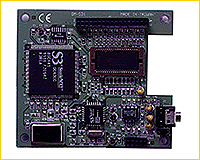 BM-S3X / S3 CP-3
BM-S3X / S3 CP-3
Launched: ?
Bus: LPB (Local Peripheral Bus)
Chipset: ?
Memory: ?
FCC ID: ?
The BM-S3X was an MPEG player daughterboard that could be connected to an S3-equipped graphics card.
General Features:
- MPEG-1 video and audio decompression (30 frames per second/CD-quality audio)
- Complete audio and video synchronization support
Video Featrues:
- MPEG-1 video slow playback,fast search,fast forward,freeze frame,audio mute,single step,and random access.
- MPEG-1 video error detection and resynchronization.
- 4:2:2 video data format output.
Audio Features:
- Decompression of any MPEG-1 level 1 or 2 compressed audio bit stream
- 32,44.1 and 48KHz sampling rates.
32 to 44.8K bit/sec compressed bit rates.
System Interface:
- 8-bit local peripheral Bus (LPB) interface to an S3 graphics/video accelerator
Software Support:
- CD-I movies ("Green Book")
- Video CD movies ("White Book")
- Microsoft Windows MCI MPGE API
- Open MPEG (OM-1)DOS API
 PD2 VGA
PD2 VGA
Launched: 1993?
Bus: ISA 16-bit
Chipset: Western Digital (WD90C30 or WD90C33 possibly?)
Memory: 512 KB or 1 MB DRAM
FCC ID: ?
Price: ?
The PD2 VGA had a maximum resolution of 1024 x 768. It could be configured via jumper to run either 31.5 kHz or 40 kHz horizontal frequency to support 60/70 Hz or 75/88 Hz vertical refresh rate. It also supported 56-72 Hz refresh rate at 800 x 600, with 60 and 70 Hz possible non-interlaced.
 ViewTop PCI
ViewTop PCI
Launched: 1993
Bus: PCI
Chipset: Tseng Labs ET4000/W32p
Memory: 1 MB
FCC ID: ILLETW32
 MPEG-II VGA
MPEG-II VGA
Launched: ?
Bus: ?
Chipset: SiS 6326
Memory: ?
FCC ID: ?
 3D Titan 1000
3D Titan 1000
Launched: 1995
Bus: PCI
Chipset: S3 ViRGE (86C325)
Memory: ?
FCC ID: ?
 3D Titan 2000
3D Titan 2000
Launched: 1997
Bus: PCI
Chipset: S3 ViRGE/DX (86C375)
Memory: ?
FCC ID: ?
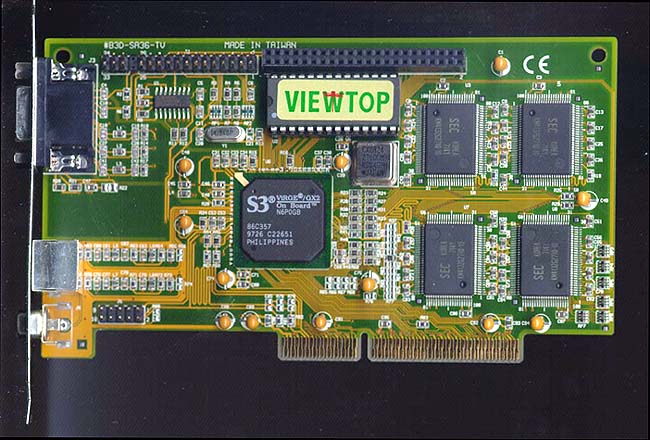 3D Titan 3000 / B30-SA36-TV
3D Titan 3000 / B30-SA36-TV
Launched: 1997
Bus: PCI or AGP 1x
Chipset: S3 ViRGE/GX2 (86C357)
Memory: 2 MB or 4 MB SGRAM
FCC ID: ?
Specifications:
- S3 ViRGE/GX2 64bit 2D/3D Graphics Acceleration, which is 328-pin PBGA package.
- Integrated 170MHz RAMDAC and Programmable Clock generator.
- Improved Video Playback Acceleration.
- Improved S3d Graphics Engine :
-Flat and Gouraud shading
-Video Texture Mapping
-Z-Buffering - High Quality horizontal and vertical video scaling (X+Y interpolation).
- Memory Support 2MB~4MB SGRAM.
- Display Resolution up to 1600x1200, NI.
- Vertical Refresh Rate up to 200Hz.
- Support DDC 1/2.0B.
- Integrated NTSC and PAL TV-Output:
- DuoView simultaneous output of independent images on TV and VGA display.
- 3-line flicker filter ensures stable quality display on TV.
- Support Super VHS, Composite AV to TV.
- Underscan compensation for VGA output to TV - AGP Bus 1.0 (You need a AGP Bus supported mainboard.)
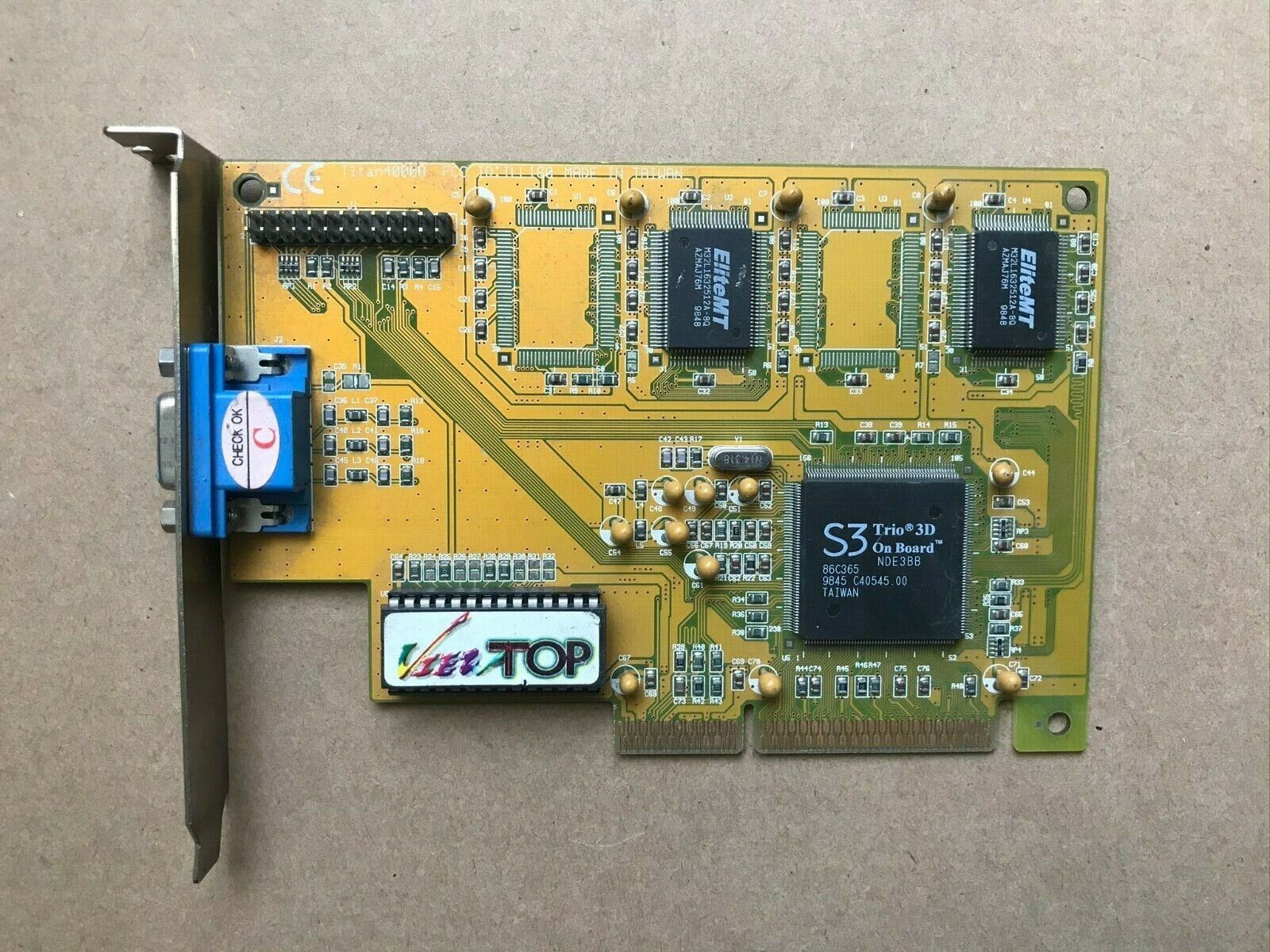 Titan 4000 / Titan 4000A
Titan 4000 / Titan 4000A
Launched: 1996
Bus: AGP 1x
Chipset: S3 Trio3D
Memory: 4 MB SDRAM
FCC ID: ILL160
230 MHz RAMDAC, 4 MB SDRAM, 128-bit 2D/3D graphics engine.
More Images
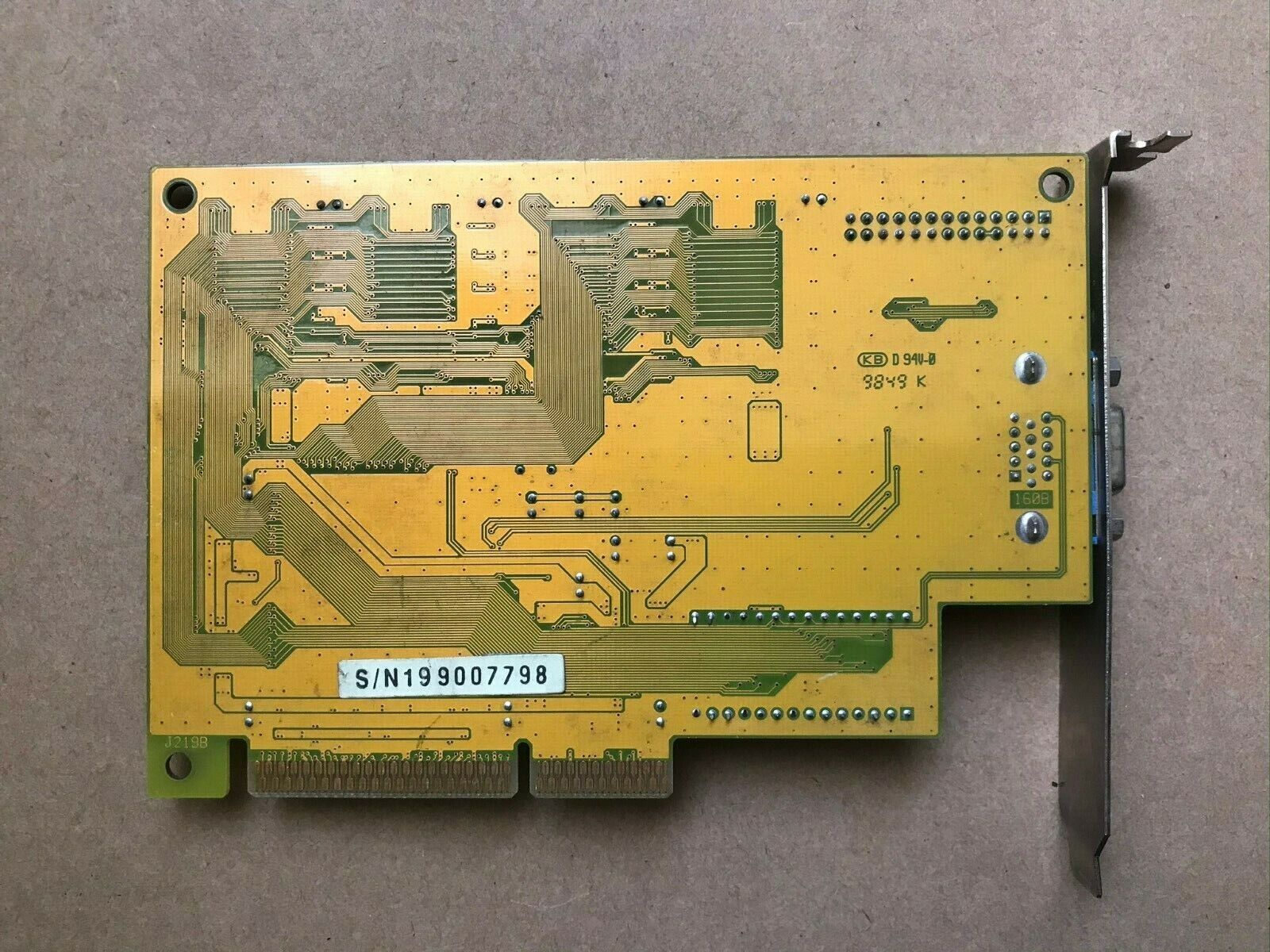
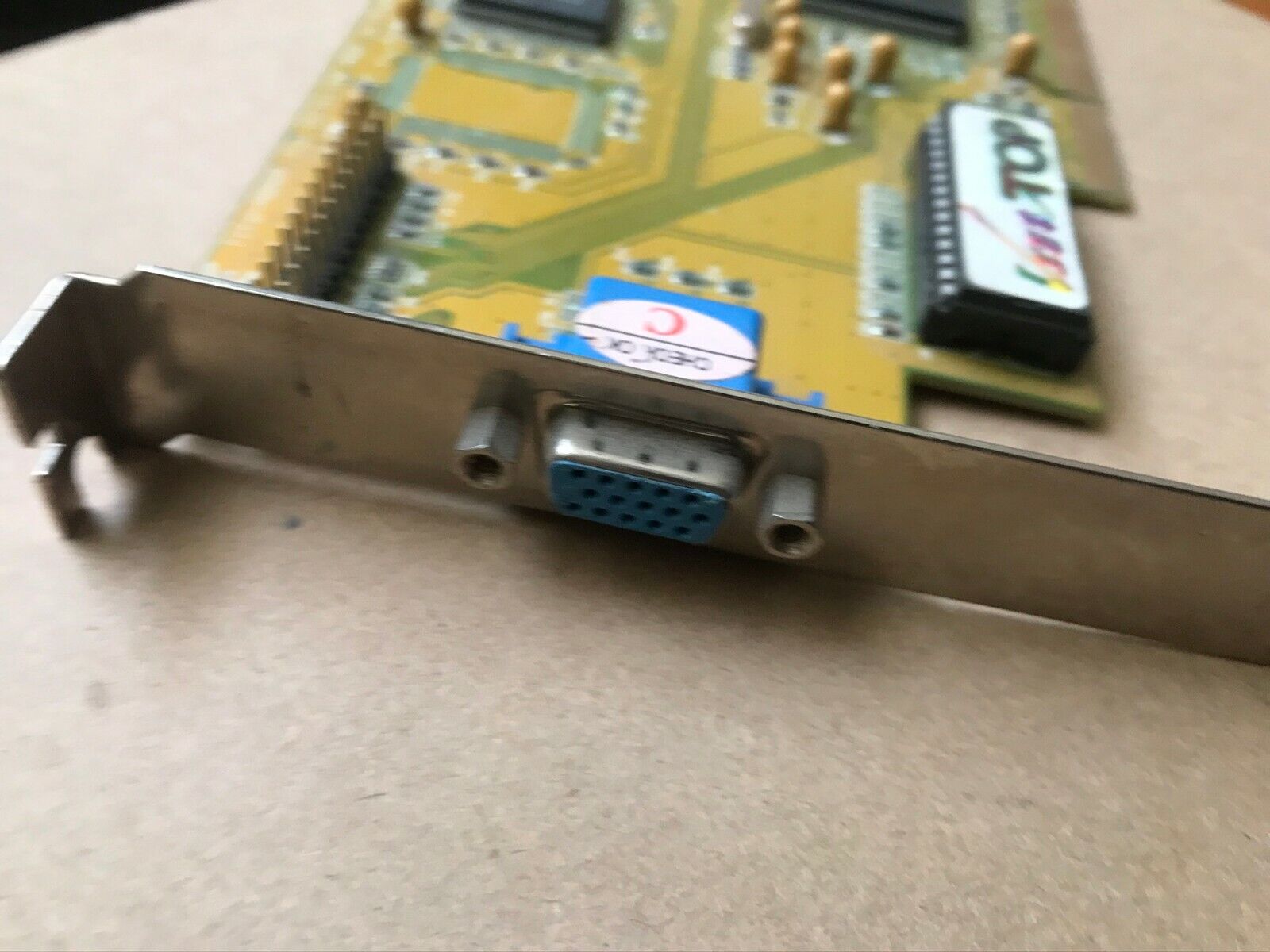
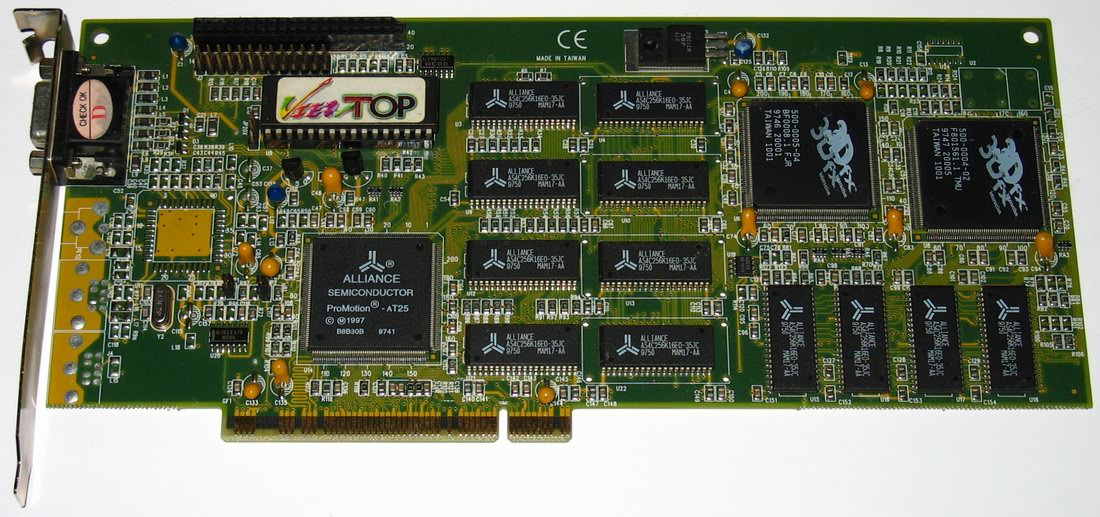 3D Vulcan / 3D Vulcan G
3D Vulcan / 3D Vulcan G
Launched: 1997
Bus: PCI
Chipset: Alliance ProMotion AT25 + 3Dfx Voodoo
Memory: 6 MB
FCC ID: ?
This card was a combined 2D/3D graphics accelerator comprising an Alliance ProMotion AT25 (for 2D) and 3Dfx Voodoo (for 3D).
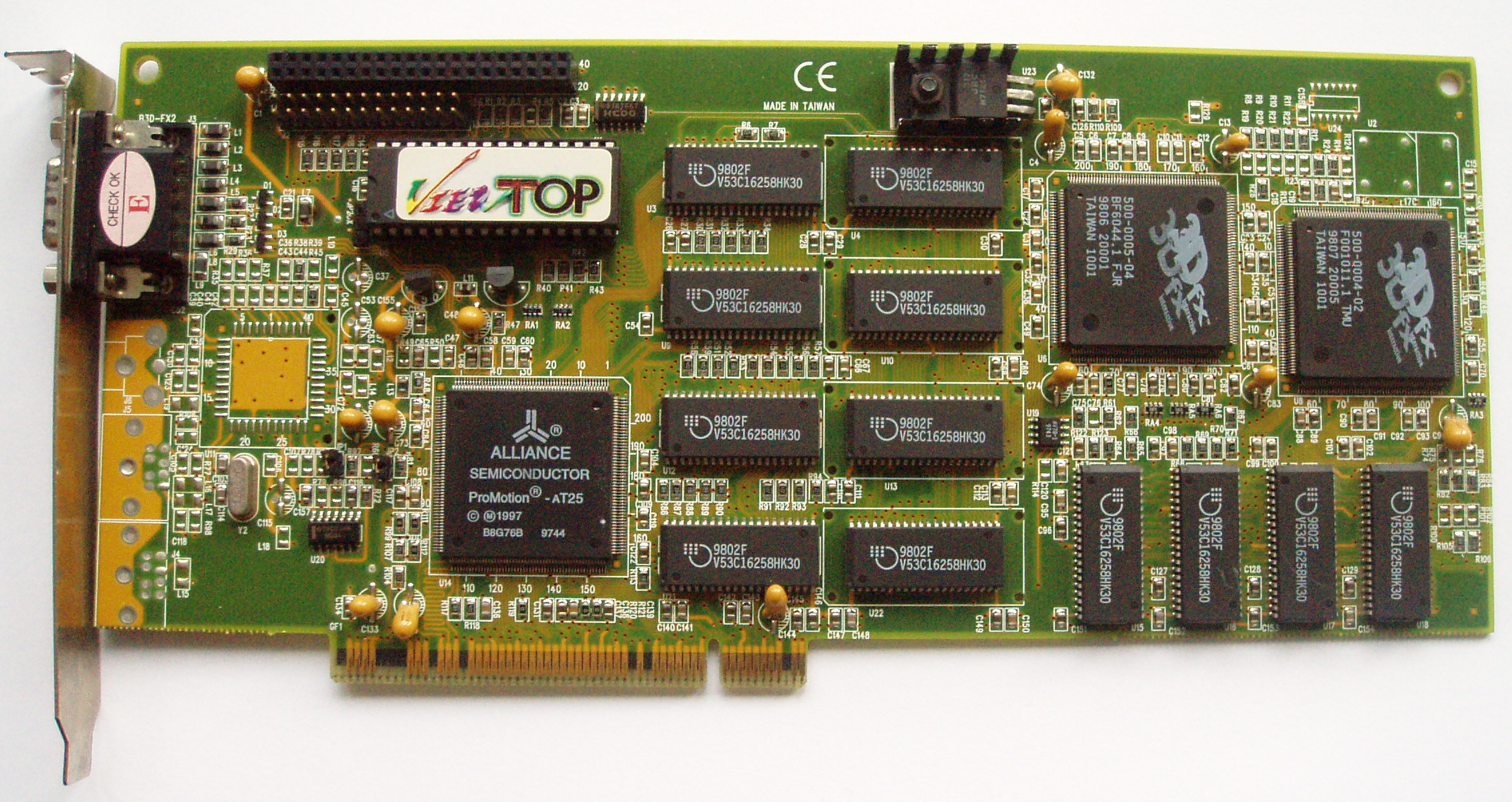 3D Vulcan B3D-FX1 / B3D-FX2
3D Vulcan B3D-FX1 / B3D-FX2
Launched: 1998
Bus: PCI
Chipset: Alliance ProMotion AT25 + 3dfx Voodoo Rush (SST96)
Memory: 6 MB
FCC ID: ?
The B3D-FX2 is OpenGL 1.1.0 compliant. The 3D Voodoo Rush portion of the card has 2 MB of the video memory allocated to it for 3D textures, while the AT25 has 4 MB. Both run at approx. 50 MHz.
- VIEWTOP 128-Bit 2D GUI Accelerator
- Integrated 170MHz DAC
- 3D/fx Interactive Voodoo Rush Game Accelerator
- VMI port support for TV-Tuner and DVD.
- Optional 3D VR Connector-3D Glasses.
- 2M or 4M bytes of GUI memory and 2 Mbytes EDO DRAM of texture memory
- NTSC/PAL TV-OUT Features: For simultaneous output to TV and VGA display, Anti-flicker filter for stable quality display on TV, Supports Super VHS, Composite AV to TV.
Advanced Features:
- Perspective correct texture mapping
- Bi-linear and tri-linear texture filtering
- Level-of-detail (LOD) MIP mapping
- Sub-pixel and sub-texel correction
- Gouraud shading and texture modulation
- Full 24-bit rendering, dithered to 16-bit RGB
- 13 texture formats including 8-bit compressed and 8-bit paletted formats
- Full bi-linear blending of paletted and compressed textures
- Anti-aliasing
- Depth buffering (16-bit linear, 22-bit effective)
- Alpha blending
- Per-pixel special effects: fog, transparency, translucency
- Texture compositing, morphing, animation
- Linear frame buffer access
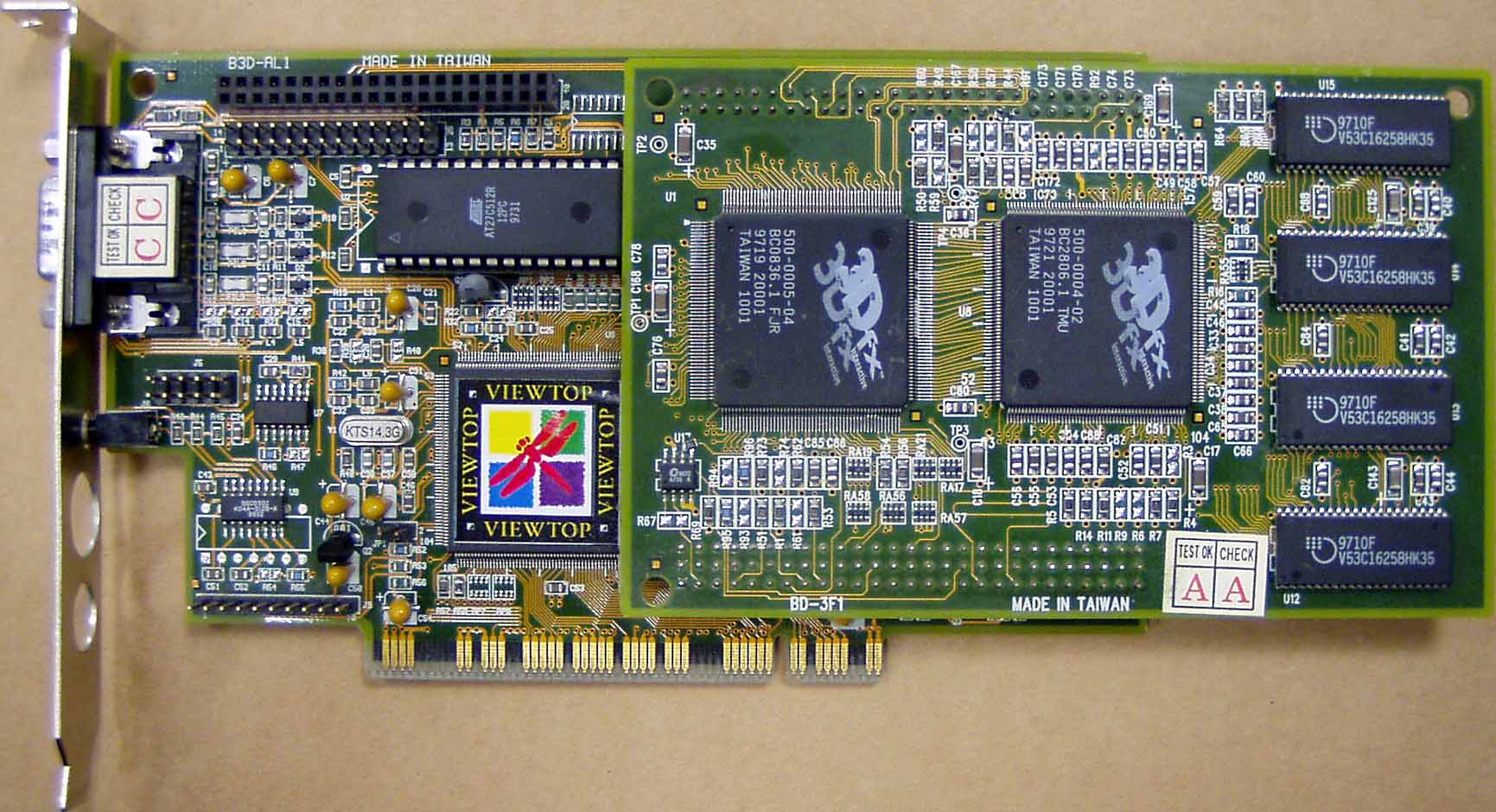 3D Voodoo-1 / B3D-3F1 / B3D-3F1-TV
3D Voodoo-1 / B3D-3F1 / B3D-3F1-TV
Launched: 1997
Bus: PCI
Chipset: 3Dfx Voodoo Rush (SST-96)
Memory: 4 MB
FCC ID: ILLFXG150C
The 3D Voodoo-1 was based on the 3Dfx Voodoo Rush 2D and 3D graphics accelerator chipset. Two model variants existed: B3D-3F1 (no TV output) and B3D-3F1-TV (with NTSC/PAL TV output). Both came with 4 MB of video RAM, with 64-bit 45-50 MHz addressing.
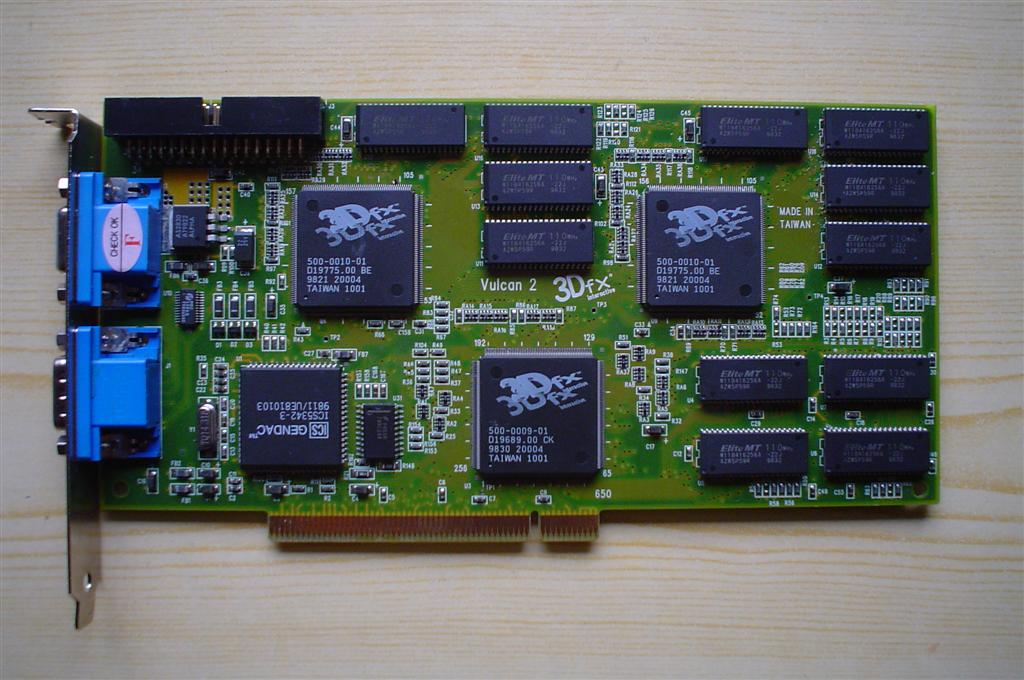 3D Vulcan 2
3D Vulcan 2
Launched: 1998
Bus: PCI
Chipset: 3Dfx Voodoo 2
Memory: 12 MB
Price: ?
FCC ID: ILL152
The ViewTop 3D Vulcan 2 was based on the 3Dfx Voodoo 2 chipset, and so was a dedicated 3D accelerator card that required a separate 2D video card in the host PC. It came with a 135 MHz RAMDAC, 12 MB of video RAM of which 4 MB was the 3D frame buffer and a further 8 MB for the 3D texture buffer.
More Images
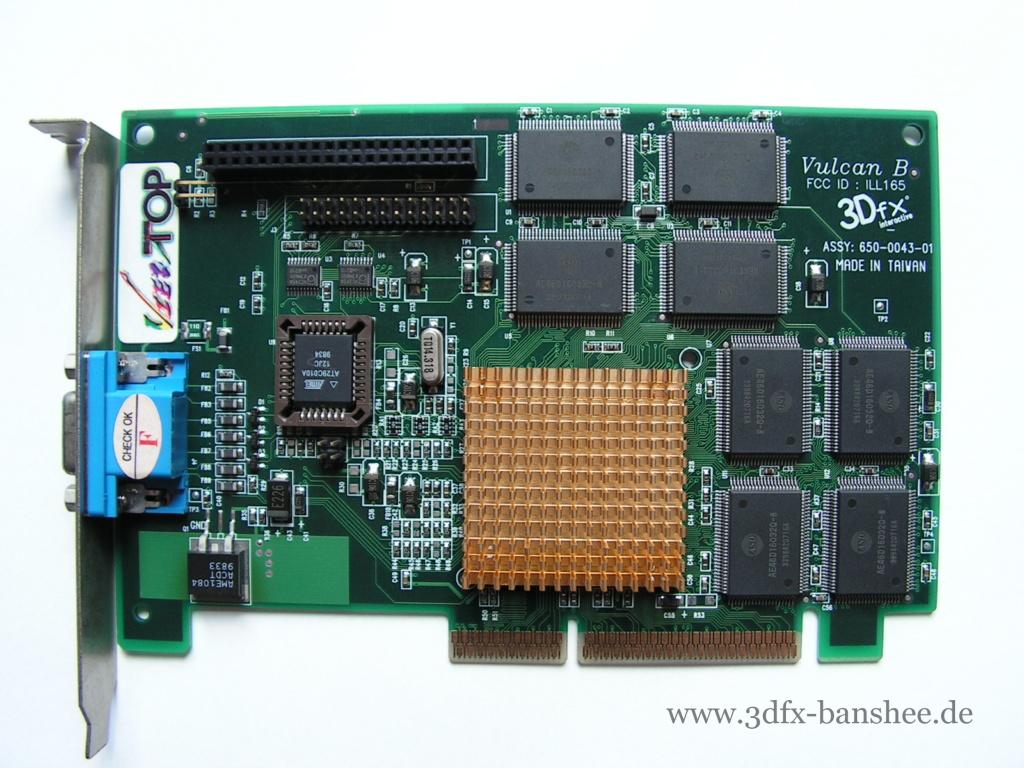 3D Vulcan B
3D Vulcan B
Launched: 1998
Bus: AGP 2x
Chipset: 3Dfx Voodoo Banshee
Memory: 16 MB SGRAM
Known BIOS Versions: 1.00.03-ET
FCC ID: ILL165
The ViewTop 3D Vulcan B was based on the 3Dfx Voodoo Banshee chipset, a combined 2D and 3D accelerator card that arrived in 1998. It came with a 230 MHz RAMDAC, 16 MB SGRAM, and 100 MHz core clock 128-bit 2D graphics engine. The video memory clock ran at 115 MHz.
- Fully integrated 128-bit VGA/2D/3D/Video Accelerator
- Ultimate 3D experience with 100 Mpixels/sec and 4 Million triangles/sec 3D performance
- No-compromise 3D image quality at frame rates
- Optimized for software DVD acceleration
- Digital video output for NTSC and PAL TV-out support (optional)
- Full VMI interface (including a host port) for optional:
- Full hardware DVD decoding, Video capturing, TV tuner support
- High-resolution 1600x1200 85Hz with a 230MHz RAMDAC
- HDTV 1900x1600 75Hz with an optional 250MHz RAMDAC
- Supports 16MB SGRAM/SDRAM frame buffer
- PC97 and PC98 rev 1.0 compliant
- VESA DDC2B support
2D Acceleration Specs:
- 100 MHz single-cycle 128-bit Windows GUI Acceleration
- Full featured 128-bit BitBlt Engine
- Hardware acceleration for Bresenham line draw, 2-edge polygon fill, Scissor/rectangle Clippers, and Full 256 ROPs
- Source and Destination Chroma-keying for DirectDraw
- SGRAM color expansion support
- 8, 16, 24, 32 bpp modes
3D Acceleration Specs:
- Full hardware setup of triangle parameters
- Support for multi-triangle strips and fans
- 16-bit integer and floating-point Z-buffering with biasing
- Transparency and chroma-key with dedicated color mask
- Alpha blending on source and destination pixels
- Sub-pixel and sub-texel correction to 0.4x0.4 resolution
- 24-bit color dithering to native 16-bit RGB
- Per-pixel atmospheric fog with programmable fog zones
- Polygon edge anti-aliasing
- Perspective correct (true divide-per-pixel) 3D texture mapping
- True per-pixel, LOD MIP mapping with biasing and clamping
- High performance bilinear and trilinear filtering
- RGB modulation/addition/blending combines textures and shaded pixels
- Texture compositing for multi-texture special effects
- Support for 14 texture map formats
- 8-bit paletted textures with full bilinear filtering
- Texture compression through narrow-channel YAB format
Video Acceleration Specs:
- Multiple video window support
- Bilinear horizontal and vertical filtering
- YUV 4:2:2, and YUV 4:2:0 planar support
- De-interlacing using Bob and Weave
- Auto page flipping using VBI for smooth motion video
- Triple 512x8 color lookup tables with separate gamma correction for video and graphics
More Images
 3D Harpoon
3D Harpoon
Launched: 1998
Bus: AGP 1x
Chipset: nVidia Riva 128ZX
Memory: 8 MB SGRAM
Price: ?
FCC ID: ILL159
250 MHz RAMDAC, 8 MB video memory, 100 MHz 128-bit 2D graphics engine.
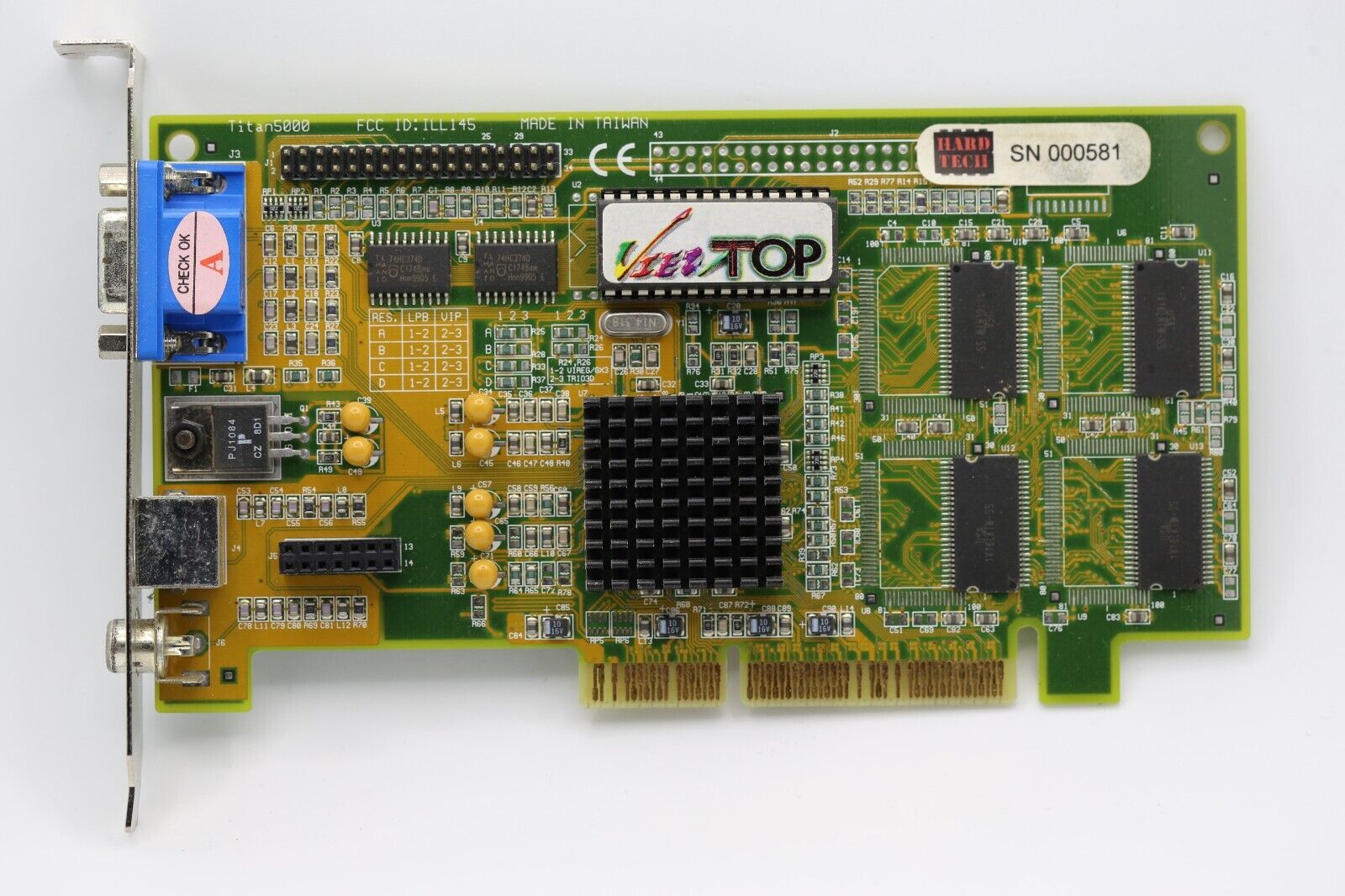 Titan 5000
Titan 5000
Launched: 1999
Bus: AGP 2x
Chipset: S3 Savage3D
Memory: 2 MB, 4 MB or 8 MB SGRAM or SDRAM (125 MHz, 64-bit synchronous memory bus, 512Kx32K or 256Kx32K parts, Block Write support)
FCC ID: ILL145
- 250MHz RAMDAC with Gamma Correction
- I 2C serial communications bus and flash ROM support
- PCI power management registers
- Hardware and BIOS support for VESA timings and DDC monitor communications
- AGP 2.0 and PCI 2.1 support with full bus mastering
2D Acceleration Specs:
- Highly Optimized 128-bit graphics engine
- Full featured 2D rasterizer for acceleration of bitblt, line draw, rectangle fill, panning and hardware cursor
- 8, 16, and 32-bpp mode acceleration
- Multi-monitor support
3D Acceleration Specs:
- Floating point triangle setup engine
- Single-cycle 3D architecture
- 128-bit with dual rendering pipelines
- 5M triangles/second peak
- 125M pixels/sec trilinear fill rate
- Full AGP-2X implementation
3D Rendering Specs:
- S3 Texture Compression, now called Microsoft Texture Compression in Direct X 6
- Single-cycle trilinear filtering
- True color rendering
- Void and cluster dithering for 16-bit modes
- Specular lighting and diffuse shading
- Alpha blending modes
- Multiple textures
- Edge anti-aliasing
- Vertex and table fog
- 16 or 24-bit Z-buffering
- MPEG-2 video textures
- Hardware-assisted bump mapping and anisotrophic filtering
- Special effects such as Sprite Anti-Aliasing, reflection and enviroment mapping, texture morphing, shadows, procedural textures and atmospheric effects
- Performance: 125MB pixels/sec trilinear fill rate, 5M triangles/second peak, S3 Texture Compression delivers 6X the amount of textures
High-Definition Video Acceleration Specs:
- High quality front end up/down scalar
- Planar to packed format conversion
- Hardware subpicture blending and highlights
- Motion compensation for full speed DVD video playback (Optional)
- Supports multiple video windows for video conferencing
- Brightness, hue, and saturation controls
- 60MHz VIP video port supports HDO input resolutions
TV Out:
- Integrated NTSC/PAL encoder
- Macrovision 7.1 support (Optional)
- Programmable flicker filter and vertical overscan compensation
- Simultaneous CRT and TV display
Host Interface:
- High performance AGP 2X 133MHz interface
- Optimized AGP support for execute mode, sideband addressing and pipelining
- PCI v2.1 bus interface runs at 33 and 66MHz
- FIFO optimized for high speed bursting of geometry and texture data
- Optimized for Slot 1 CPU (Pentium II & Celeron A) I/O architecture
Sound Cards
There is almost no information online about Britek Electronics' sound card range, but the following cards are known to exist:
|
| YOUR BEST CHOICE FOR MULTIMEDIA COMPATIBLE MUSIC SYNTHESIZER MIDI Interface Game Port Stereo Digitized Sound Microphonc,Stereo Line-in, CD-Audio,Music Synthesizer. Stereo Digital/Analog Mixer Digitized sounds,CD-Audio,Line-in, Music synthesizer and Microphone. Audio Output: QSound 3D Audio effector increase human's hearing. System Requirement: |
 PCI Bus Digital Audio and Music Player
PCI Bus Digital Audio and Music Player
Launched: 1995
Bus: ISA 16-bit or PCI(?)
FCC ID: ILLAS1?
- 100% DOS Legacy Compatible
- MUSIC SYNTHESIZER
- GAME PORT - Single or Dual joystick.
- 3 Stereo + 3 mono inputs mixed into output
- Recording and Playback
- Full 32 voice polyphony
- Includes two and four megabyte General MIDI\
Roland MT-32 sound sets as well as AdLib\
SoundBlaster Pro I (with OPL2) FM synthesizer emulation.
- Reverb and Chorus MIDI effect.
- Allows the recording of CD-quality stereo sound (up to 16 bits, 48.0 kHz sampling rate) from Aux, CD and TV Tuner inputs Allows the recording of mono sound from the Mic input with or without 5 volt BIAS power or 30db boost.
- Allows the recording of mono sound from the Modem\ TAD input/output.
- Playback of stereo wave samples of 8- or 16-bit sound.
- MIXERS
- DRIVER for
- What You Need
Provided software mixer allows synthesizer and digital audio output to be mixed with signal arriving at the card CD, Aux, Mic, Modem and TV Tuner inputs.
- DOS & Windows3.XX
- Windows 95 / NT 4.0
- 75MHz Pentium processor or better
- Windows 3.x / 95 or NT 4.0
- One open PCI expansion slot
- At least 12 MB of free hard disk space (to install all software and samples)
- Enough RAM to accommodate the system, plus the waveset chosen (2MB and 4MB wavesets included)
- You will also need a set of powered speakers or headphones.
 WaveCom 32
WaveCom 32
Launched: 1996?
Bus: ISA 16-bit or PCI(?)
FCC ID: ILLAD01?
 Unknown
Unknown
Launched: 1996
Bus: ISA 16-bit or PCI(?)
FCC ID: ILLA108
.jpg) BP-ET4 / ET4000AX
BP-ET4 / ET4000AX.jpg)
.jpg)
.jpg)
.jpg)
.jpg)
.jpg)
.jpg)
.jpg)
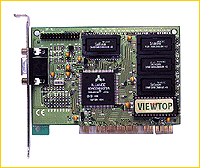
 AT-24 PCI 128bit GUI accelerator
AT-24 PCI 128bit GUI accelerator